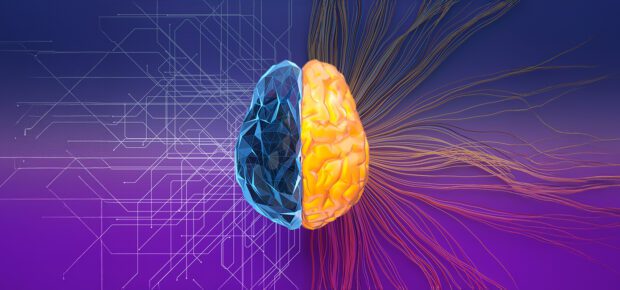November 11, 2025
Summary:
- Neuro-symbolic AI blends two major branches of artificial intelligence: neural networks, which learn to identify patterns from data, and symbolic reasoning systems, which apply explicit rules and logic to draw conclusions.
- It’s often referred to as the third wave of artificial intelligence, and has drawn significant attention from the research community and businesses because it can address weaknesses each approach has on its own.
- It’s already used by some large businesses, such as robots in warehouses, and has promising applications in other autonomous systems.
Neuro-symbolic AI is often referred to as the “third-wave” of artificial intelligence because it combines two types of AI to solve problems each one struggles with on its own. Its name provides clues as to how it works.
The “neuro” part of the name refers to neural networks, which have become the dominant AI approach since the 1980s. They are great at learning from data. They recognize patterns and they power the large language models behind generative AI systems.
The “symbolic” portion of the name refers to symbolic reasoning systems, which were part of a first wave of AI research dating back to the 1950s. It involved teaching computers to follow clear, logical rules and make inferences from them. A symbolic system might have a rule stating, “All mammals have lungs.” It can infer “Whales have lungs” if it knows whales are mammals.
In this Q&A, IEEE Fellow Houbing Song explains why this emerging paradigm has captured the attention of researchers and industry leaders alike.
What’s behind the need to combine these two distinct AI approaches?
Neural networks excel in unknown environments because they can learn, but their processes are often opaque and difficult to understand. We don’t know how these systems make the decisions they make, leading to poor explainability. Symbolic systems are effective in familiar environments because they follow established rules. Symbolic systems struggle to generalize in new situations, resulting in a lack of robustness.
Researchers wanted to find a solution to address the explainability challenge faced by neural networks, particularly deep learning, and the generalizability and robustness challenges faced by symbolic reasoning.
Was this dual approach of ‘learning’ and ‘reasoning’ inspired by any specific models from psychology or cognitive science?
Neuro-symbolic AI mirrors psychologist Daniel Kahneman’s idea that people think in two ways — one fast and intuitive, the other slow and logical.
The fast and intuitive system is very good at pattern recognition and is a lot like deep learning and neural networks. The slow and logical style of thinking is a lot like symbolic reasoning systems: good at planning, deduction and deliberative thinking.
Both are needed for a robust, assured and trustworthy AI that can learn, reason and interact with humans to accept advice and answer questions.
How does neuro-symbolic AI improve on today’s mainstream AI systems?
Compared with today’s mainstream AI systems, neuro-symbolic AI systems are able to understand the concepts they reason over and operate with, change their behavior appropriately in response to contextual interventions and align their operations with societal expectations and human intentions.
Can you give a simple real-world example of where neuro-symbolic AI would shine? From a recent lecture you gave for the IEEE Intelligent Systems Council , it appears to have promise in autonomous vehicles. Why does neuro-symbolic AI improve on current tech?
Autonomous systems, enabled by neuro-symbolic AI, will operate safely and perform as intended. For example, some very large companies are using neuro-symbolic AI to enhance the performance, reliability and safety of their robotics fleet in fulfillment centers. They use symbolic reasoning for spatial problems, such as figuring out the optimal place to pick up an item or put it down, and use neural networks to enable them to handle perception tasks, including categorizing images.
What are the biggest technical challenges in making neuro-symbolic AI work?
The biggest technical challenge in making neuro-symbolic AI work is how to integrate neural networks with symbolic reasoning. Researchers have tried several ways to combine them — running the systems one after another (serial), side-by-side (parallel), placing a neural component inside a symbolic engine or putting a symbolic engine inside a neural network. However, the best approach for integration has yet to be discovered.
Learn More: If you are interested in a deeper dive into neuro-symbolic systems, check out IEEE Fellow Houbing Herbert Song’s webinar on the topic, presented by the IEEE Systems Council.






 Meaningful Momentum or Running in Place?
Meaningful Momentum or Running in Place? AI Through Our Ages
AI Through Our Ages Liquid Infrastructure: Our Planet's Most Precious Resource
Liquid Infrastructure: Our Planet's Most Precious Resource The Impact of Technology in 2025
The Impact of Technology in 2025 Quantum and AI: Safeguards or Threats to Cybersecurity?
Quantum and AI: Safeguards or Threats to Cybersecurity? Why AI Can't Live Without Us
Why AI Can't Live Without Us Bits, Bytes, Buildings and Bridges: Digital-Driven Infrastructure
Bits, Bytes, Buildings and Bridges: Digital-Driven Infrastructure Impact of Technology in 2024
Impact of Technology in 2024 Emerging AI Cybersecurity Challenges and Solutions
Emerging AI Cybersecurity Challenges and Solutions The Skies are Unlimited
The Skies are Unlimited Smart Cities 2030: How Tech is Reshaping Urbanscapes
Smart Cities 2030: How Tech is Reshaping Urbanscapes Impact of Technology 2023
Impact of Technology 2023 Cybersecurity for Life-Changing Innovations
Cybersecurity for Life-Changing Innovations Smarter Wearables Healthier Life
Smarter Wearables Healthier Life Infrastructure In Motion
Infrastructure In Motion The Impact of Tech in 2022 and Beyond
The Impact of Tech in 2022 and Beyond Cybersecurity, Technology and Protecting Our World
Cybersecurity, Technology and Protecting Our World How Technology Helps us Understand Our Health and Wellness
How Technology Helps us Understand Our Health and Wellness The Resilience of Humanity
The Resilience of Humanity Harnessing and Sustaining our Natural Resources
Harnessing and Sustaining our Natural Resources Creating Healthy Spaces Through Technology
Creating Healthy Spaces Through Technology Exceptional Infrastructure Challenges, Technology and Humanity
Exceptional Infrastructure Challenges, Technology and Humanity The Global Impact of IEEE's 802 Standards
The Global Impact of IEEE's 802 Standards Scenes of our Cyber Lives: The Security Threats and Technology Solutions Protecting Us
Scenes of our Cyber Lives: The Security Threats and Technology Solutions Protecting Us How Millennial Parents are Embracing Health and Wellness Technologies for Their Generation Alpha Kids
How Millennial Parents are Embracing Health and Wellness Technologies for Their Generation Alpha Kids Space Exploration, Technology and Our Lives
Space Exploration, Technology and Our Lives Global Innovation and the Environment
Global Innovation and the Environment How Technology, Privacy and Security are Changing Each Other (And Us)
How Technology, Privacy and Security are Changing Each Other (And Us) Find us in booth 31506, LVCC South Hall 3 and experience the Technology Moon Walk
Find us in booth 31506, LVCC South Hall 3 and experience the Technology Moon Walk Virtual and Mixed Reality
Virtual and Mixed Reality How Robots are Improving our Health
How Robots are Improving our Health IEEE Experts and the Robots They are Teaching
IEEE Experts and the Robots They are Teaching See how millennial parents around the world see AI impacting the lives of their tech-infused offspring
See how millennial parents around the world see AI impacting the lives of their tech-infused offspring Take the journey from farm to table and learn how IoT will help us reach the rising demand for food production
Take the journey from farm to table and learn how IoT will help us reach the rising demand for food production Watch technical experts discuss the latest cyber threats
Watch technical experts discuss the latest cyber threats Explore how researchers, teachers, explorers, healthcare and medical professionals use immersive technologies
Explore how researchers, teachers, explorers, healthcare and medical professionals use immersive technologies Follow the timeline to see how Generation AI will be impacted by technology
Follow the timeline to see how Generation AI will be impacted by technology Learn how your IoT data can be used by experiencing a day in a connected life
Learn how your IoT data can be used by experiencing a day in a connected life Listen to technical experts discuss the biggest security threats today
Listen to technical experts discuss the biggest security threats today See how tech has influenced and evolved with the Games
See how tech has influenced and evolved with the Games Enter our virtual home to explore the IoT (Internet of Things) technologies
Enter our virtual home to explore the IoT (Internet of Things) technologies Explore an interactive map showcasing exciting innovations in robotics
Explore an interactive map showcasing exciting innovations in robotics Interactively explore A.I. in recent Hollywood movies
Interactively explore A.I. in recent Hollywood movies Get immersed in technologies that will improve patients' lives
Get immersed in technologies that will improve patients' lives